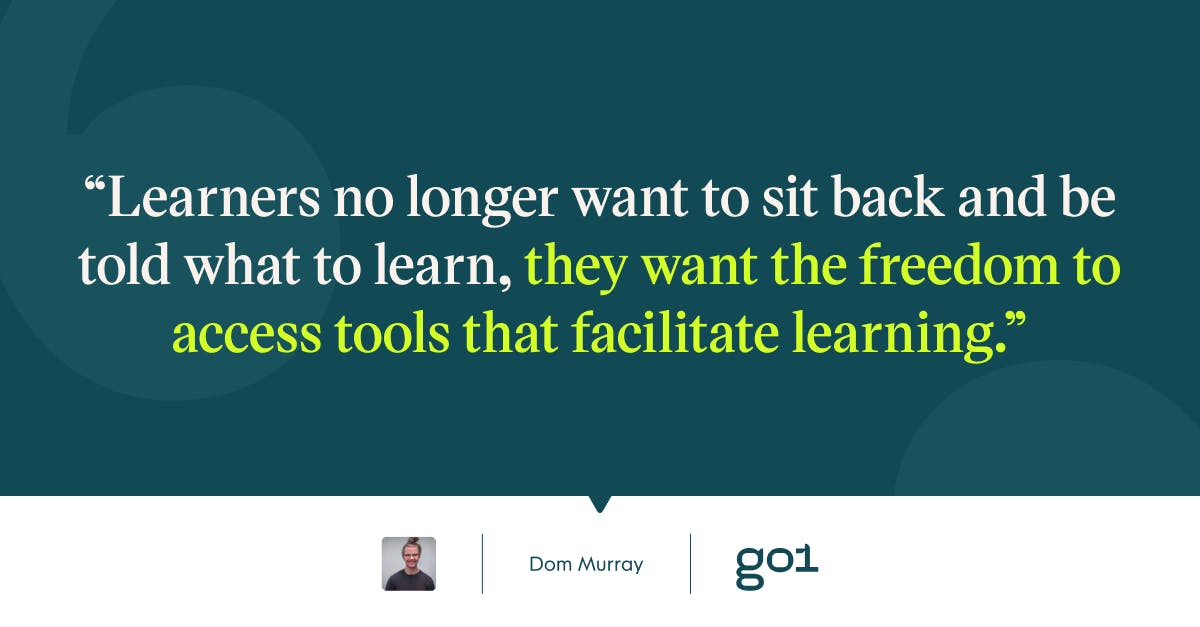
The benefits of self-directed learning

In an era of YouTube tutorials, smartphones, and world-class digital learning courses — where information is only ever a click away — self-directed learning was an inevitable evolution. With employees asking for more and more control in many facets of life, from remote working to mental health support and beyond, it was only a matter of time before self-directed training took off.
Recently, we identified self-directed learning as one of the top L&D trends of 2021. And with good reason. The benefits of self-led learning are far-reaching, with 77% of employees saying it is more effective than their company’s training. This should not be seen as a knock on the state of learning, but rather as a glowing endorsement of self-directed training.
On an intuitive level, this makes plenty of sense. After all, who knows better how you prefer to learn, what you need to learn, and where your skill gaps lie: you, or a generic assigned learning program? Learners no longer want to sit back and be told what to learn, they want the freedom to access tools that facilitate learning. Ideally, at their own pace and on their own schedule.

With this in mind, we thought self-directed learning merited closer attention. We’ll start by asking ‘what is self-directed learning?’, before moving on to examples and benefits of self-directed training.
What is self-directed learning?
Self-directed learning is many things. It’s flexible. It’s decentralised. And it puts the learner first. But most of all, self-directed learning is here to stay.

On a basic level, self-directed learning is exactly what it sounds like. Sometimes known as self-led learning or self-determined learning, this style of learning gives people control over what they learn, how they learn, and what learning schedule best suits them. Self-led learning takes the onus off a central L&D strategy and puts it into learners’ hands, allowing them to set goals and access training in ways that best complement their unique learning needs.
The birth of self-directed learning
Most sources attribute Malcolm Knowles, sometimes known as the “father of self-directed learning”, as one of the key pioneers of this concept back in 1975. Knowles believed that adult learners are “mature, responsible individuals who want to take charge of their own learning.” Thus, he defined self-directed learning as a process “in which individuals take the initiative, with or without the help of others, in diagnosing their learning needs, formulating learning goals, identifying human and material resources for learning, choosing and implementing appropriate learning strategies, and evaluating those learning outcomes.”
Defining self-directed learning
In a 2008 research paper, Loyens, Magda, and Riker define self-directed training as “knowing what you need to learn, how to learn it, and being able to judge if you’ve learnt it. It assumes that learners have a role in selecting those learning tasks that fit their learning needs.”
Therefore, self-determined learning places a significant amount of trust and responsibility on learners to identify and fulfil their learning needs. However, 360Learning emphasises the distinction between self-directed and unstructured or unsupervised learning. As they put it, “just because self-directed learning makes learners more responsible for those things doesn’t mean it makes them solely responsible.”
L&D teams must still play an active role in facilitating and supporting self-directed learning. For example, L&D teams must ensure learning content is accurate, accessible, and up to date, learning goals are measurable, achievable, relevant, and aligned with broader organisational goals, and learners can access whatever support they require to achieve optimal outcomes.
Self-led learning may give learners more control, but it should not mean they feel unsupported.
Examples of self-directed learning
As more organisations recognise the benefits of self-directed learning, examples of this type of learning abound. And the results are impressive.
Many of us can probably conjure examples of self-determined learning in daily life. You might want to learn a new language and download an app to guide you on this journey. You might be interested in history and seek out a podcast to learn more. You might see a particularly captivating documentary and start Googling for more information once the final credits roll. These are all examples of informal self-determined learning in day-to-day life.
In a business context, self-led learning has also been a hit. According to research by Cornerstone, American food and energy drink company Cliff Bar saw a 198% increase in self-directed online training hours when the company began offering more timely and relevant content. To achieve this, the company launched ‘Epiphany Labs’, a company-wide learning hub that allows learners to access live sessions, lunch and learns, on-demand courses, compliance training, and more, all on their own terms.
Similarly, BNP Paribas saw a 235% increase in self-requested training from 2019 to 2020. With increases like these, it’s clear that self-directed training is on the rise, which brings us to the benefits of this style of learning.
The benefits of self-directed learning
As we’ve alluded to, the primary benefit of self-directed learning is giving learners more control over their development. Ideally, this should lead to more engaged, productive, and skilled learners.
Giving learners what they want
Already, teams are seeing the benefits of this approach, with self-determined learning growing in popularity across all generations. According to LinkedIn’s 2021 Workplace Learning report, 43% of Gen Z, 42% of Millennials, and 33% of Gen X and Baby Boomers want fully self-directed and independent learning. This report also identified that 74% of learners want the freedom to take training courses during their spare time, at their own pace. Remember, it’s never a bad time to give learners more of what they want.
Accordingly, 96% of L&D professionals say their top priority is increasing self-directed training opportunities. These figures make sense, as 77% of employees believe self-directed learning is more effective than their employer’s training.

In many ways, a shift-towards formal self-led learning is a natural progression from how employees already learn. eLearning Industry finds that employees spend far more time learning from their own sources than employer-provided training. On average, workers spend 14 hours per month learning on their own, compared to just two to three hours on employer-provided training. Likewise, 23% of workers say they completed a course of any kind in the last two years, whereas more than 70% learned something for their job from an article, video, or book in the past 24 hours.
Clearly, the demand for self-determined learning is increasing. Now, the onus is on organisations to catch up. While 43% of Gen Z employees want completely self-led learning, only 20% of companies plan to offer this level of freedom.
Organisational benefits
Many companies may be asking, ‘why should we switch to self-directed education, what’s in it for us?’. In addition to providing employees with what they want, the benefits are vast. According to Emerald Works, 50% of high-impact learning cultures provide opportunities for self-directed learning, compared to just 13% of ‘average’ organisations.

Similarly, CIPD’s Towards Maturity report finds that ‘Top Deck’ organisations (defined as companies in the top decile of their Towards Maturity Index) reported a 43% increase in self-directed training opportunities. The message is clear: the more opportunities you provide for self-led learning, the more likely you are to stand out as a top-performing, high-impact team.
There’s little doubt that self-directed learning is here to stay. Employees crave it, and many organisations are starting to reap the rewards, ranging from improved efficiency to greater job satisfaction, motivation, and retention. Self-directed learning may be one of the top learning trends of 2021, but pretty soon, it won’t just be a trend, it will be a necessity.
For more insights, be sure to subscribe to the Go1 newsletter to stay on top of all the latest L&D trends. Or, you can book a demo today to find out how Go1 can help with your team’s learning needs.




